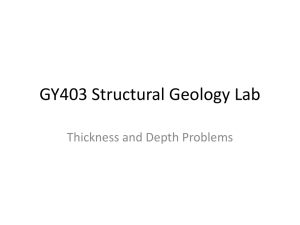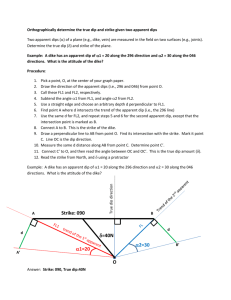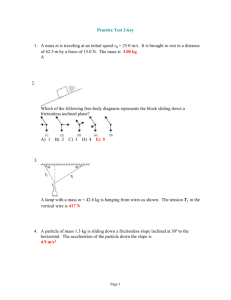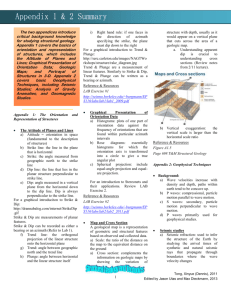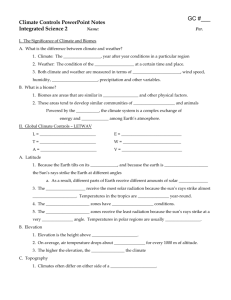Exercise 2: Measuring Strike and Dip with Google Earth
advertisement
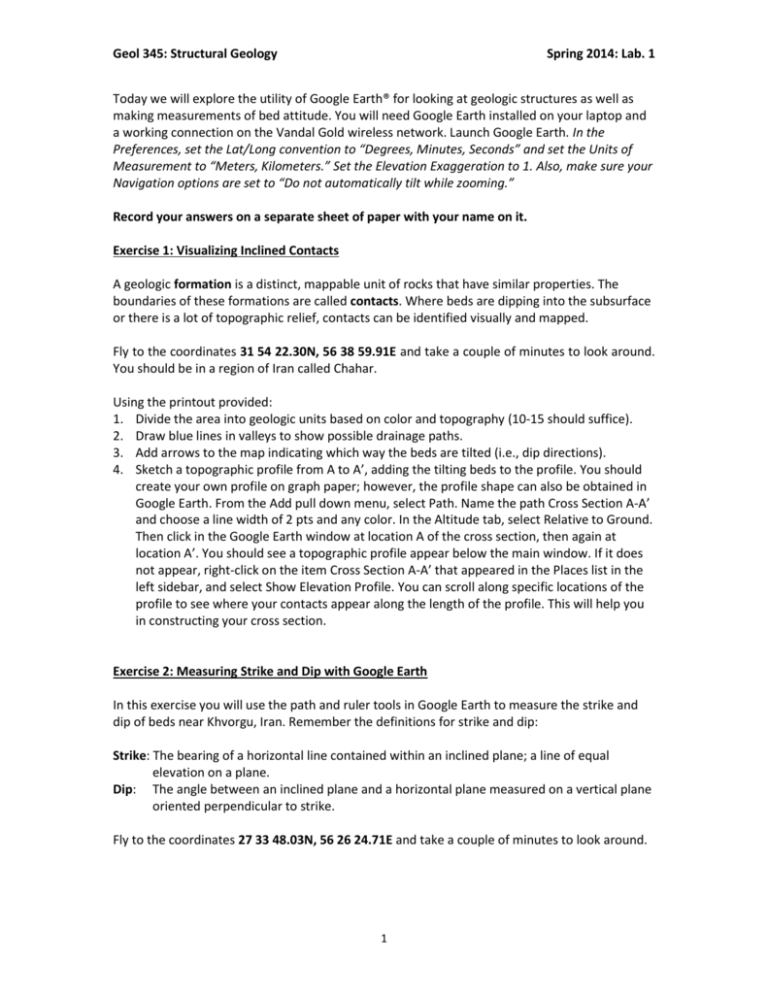
Geol 345: Structural Geology Spring 2014: Lab. 1 Today we will explore the utility of Google Earth® for looking at geologic structures as well as making measurements of bed attitude. You will need Google Earth installed on your laptop and a working connection on the Vandal Gold wireless network. Launch Google Earth. In the Preferences, set the Lat/Long convention to “Degrees, Minutes, Seconds” and set the Units of Measurement to “Meters, Kilometers.” Set the Elevation Exaggeration to 1. Also, make sure your Navigation options are set to “Do not automatically tilt while zooming.” Record your answers on a separate sheet of paper with your name on it. Exercise 1: Visualizing Inclined Contacts A geologic formation is a distinct, mappable unit of rocks that have similar properties. The boundaries of these formations are called contacts. Where beds are dipping into the subsurface or there is a lot of topographic relief, contacts can be identified visually and mapped. Fly to the coordinates 31 54 22.30N, 56 38 59.91E and take a couple of minutes to look around. You should be in a region of Iran called Chahar. Using the printout provided: 1. Divide the area into geologic units based on color and topography (10-15 should suffice). 2. Draw blue lines in valleys to show possible drainage paths. 3. Add arrows to the map indicating which way the beds are tilted (i.e., dip directions). 4. Sketch a topographic profile from A to A’, adding the tilting beds to the profile. You should create your own profile on graph paper; however, the profile shape can also be obtained in Google Earth. From the Add pull down menu, select Path. Name the path Cross Section A-A’ and choose a line width of 2 pts and any color. In the Altitude tab, select Relative to Ground. Then click in the Google Earth window at location A of the cross section, then again at location A’. You should see a topographic profile appear below the main window. If it does not appear, right-click on the item Cross Section A-A’ that appeared in the Places list in the left sidebar, and select Show Elevation Profile. You can scroll along specific locations of the profile to see where your contacts appear along the length of the profile. This will help you in constructing your cross section. Exercise 2: Measuring Strike and Dip with Google Earth In this exercise you will use the path and ruler tools in Google Earth to measure the strike and dip of beds near Khvorgu, Iran. Remember the definitions for strike and dip: Strike: The bearing of a horizontal line contained within an inclined plane; a line of equal elevation on a plane. Dip: The angle between an inclined plane and a horizontal plane measured on a vertical plane oriented perpendicular to strike. Fly to the coordinates 27 33 48.03N, 56 26 24.71E and take a couple of minutes to look around. 1 Geol 345: Structural Geology Spring 2014: Lab. 1 Part 1 First you will measure the slope of the outcrop surface. In order for your results to be comparable to the rest of the class, everyone needs to measure the same area in the flatirons: the ridge immediately to the left (southwest) of the coordinate marker in Google Earth. When measuring slope we are simply trying to find one angle of a right-angle triangle. If we have two sides of the triangle, we can calculate the dip. In this case, the two sides are represented by the ground distance down the dip slope (hypotenuse) and the change in elevation over that distance. One can also use the horizontal map distance and change in elevation. Horizontal distance Change in elevation Slope distance Identify which angle in this triangle represents the slope, . 1. Use the ruler tool to draw a line from the highest point to the lowest point on the ridge Choose the “line” tab (not “path”). Select units of meters. It is important to draw your line at what you believe to be the direction of greatest dip in order to get the most accurate measurement. 2 Geol 345: Structural Geology Spring 2014: Lab. 1 2. Record the ground length (slope distance) and the map length (horizontal) distance. 3. Hold the cursor over the top and bottom points of the line to find the two elevations (shown at the bottom of the Google Earth view window) and thus calculate the change in elevation down the slope. 4. Use the change in elevation and ground/map distance to find the slope angle. Record your results. Show that either of the following trig functions will work here: sin () = (change in elevation)/(ground length) tan () = (change in elevation)/(map length) Part 2 If you look closely as you explore along the flatirons, you will see that the actual bedding contacts are dipping more steeply than the topography (see figure below, which exaggerates the actual effect). In part one, we actually measured the slope of the ridge, not the dip of the bedding. slope of topography dip of bedding In order to measure the actual dip angle of the beds we need to use the area where the contact is exposed between the ridges. Again, in order for your data to be comparable with the rest of the class, make sure you use the drainage between the two ridges directly to the left of the coordinate marker. Contact 3 Geol 345: Structural Geology Spring 2014: Lab. 1 1. Click on the “Add” icon at the top toolbar (not the ruler icon) and select “Path”. 2. Choose the width of the line you want and the color under the “Style, Color” tab. 3. Go to the “Altitude” tab. Change the “clamped to ground” selection to “relative to ground.” Do not close this dialog box. 4. Draw a line from one edge of the contact, across the valley to the other edge. Make sure that the elevation at both ends of the line is same and record this elevation. Note: we are making an assumption here that we are correctly selecting the actual contact of this unit on both sides of the valley. 5. Click OK. You have now created a strike line for this particular contact (lines of equal elevation on a surface). 6. Repeat steps 1-6 to create another strike line at a different elevation. Record the elevation of this second strike line. Both of the lines you have created are horizontal lines that intersect with bedding. If they are strike lines on a planar surface, they should be mutually parallel. There is no specific elevation at which you need to create these lines; there are an infinite number of possibilities. Use the right-hand rule to determine the strike of the layer. 7. Now use the ruler tool to measure the map distance between the two strike lines (i.e., a line drawn perpendicular to the strike lines). 8. Now determine which trig function is appropriate to find the dip angle. Record your answer. It should be different to the slope of the surface of the flatiron. Exercise 3: Visualization of Inclined Igneous Features Fly to the coordinates 37 23 36.05N, 104 50 54.71W at Spanish Peaks, Colorado, and take a couple of minutes to look around. Focus on the area north of West Spanish Peak. The most recent imagery is not as good as the 2006 imagery, so use View>Historical Imagery to load the older images of the region. 1. What structural features stand out to you? 2. What is the general orientation of these features relative to the mountain? 3. Examine these features from the side, a “cross-section” view, in an area where the streams have eroded the features. What is the general dip of these features? 4. What are these linear features? Exercise 4: Visualizing Contacts of Beds of Variable Dip Fly to the coordinates 32 24 50.95N, 56 47 00.91E in Eastern Iran and take a couple of minutes to look around. 1. Determine the general dip of the beds on the northern and southern edges of this feature. 2. Are the dips the same, or do they vary? If they vary, describe the change in dip from the eastern edge to the western edge. 3. Given the dip of the beds, what type of feature are you looking at? 4. How do outcrop patterns (i.e., the nature of the contacts) change as the dips of the beds change? Use your observations in all four parts of today’s lab to answer this question. 4 Geol 345: Structural Geology Spring 2014: Lab. 1 Definitions: Attitude- The orientation in space of a line or plane. By convention, the attitude of a plane is expressed as its strike and dip; the attitude of a line is expressed as trend and plunge. Bearing- The horizontal angle between a line and a specified coordinate direction, usually true north; the compass direction or azimuth. Strike- The bearing of a horizontal line contained within an inclined plane. The strike is a line of equal elevation on a plane. There are an infinite number of parallel strike lines for any inclined plane. Dip- The angle between an inclined plane and a horizontal line oriented perpendicular to its strike. The direction of dip can be thought of as the direction water would run down the plane. Trend- The bearing (compass direction) of a horizontal line or the horizontal projection of an inclined (plunging) line. Plunge- The vertical angle between an inclined (plunging) line and the horizontal. Pitch- The angle measured on an inclined plane between any horizontal line (i.e., a strike line) and any other line on the inclined plane. Also called rake. Apparent dip- The vertical angle between an inclined plane and a horizontal line that is not perpendicular to the strike of the plane. For any inclined plane (except a vertical one), the true dip is always greater than any apparent dip. Note that an apparent dip may be defined by its trend and plunge or by its pitch or rake within a plane. Additional Homework: 5
